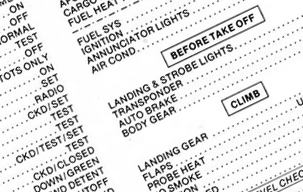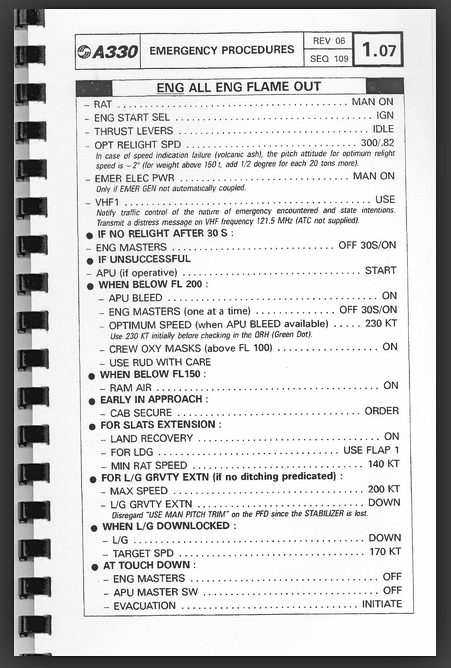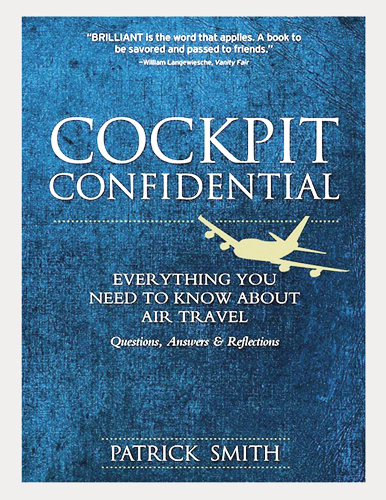Checked, Set, Roger
September 29, 2015
EVERYBODY has heard the word “checklist.” Most folks know that checklists are a staple in airline cockpits, and they get the gist of it. The term is self-descriptive; you can think of it as a grocery list of sorts — a line-by-line register of specific items, used to make sure that important tasks have been completed, and none skipped. Still, a lot of people don’t understand exactly what a cockpit checklist looks like and how the reading of one is carried out. Pardon the geekiness of what follows, but here’s how it works:
Pilots use checklists for both normal and non-normal operations: for routine situations, for malfunctions, and for emergencies. (You’ll notice I said “non-normal.” That’s a classic aviation-ism, devised in place of “abnormal” for reasons I can’t possibly fathom or explain. It’s a goofy word, but for the sake of realism we’ll stick with it.)
The non-normal checklists are bound together in an overstuffed book called the QRH, or Quick Reference Handbook. This volume contains step-by-step procedures for hundreds of potential situations or malfunctions, from minor component failures to how to prepare for an ocean ditching. The QRH is divided into chapters: electrical, hydraulic, pneumatic, etc. There are at least two in the cockpit: identical copies for the captain and first officer, always within easy reach.
The normal checklists are usually printed on an a card — paper or cardboard — sometimes laminated and often folded vertically and/or lengthwise. A single card will be divided into as many as a dozen separate checklists, each of which will be read aloud depending on the phase of flight. Wording varies airline to airline, but the individual lists will be titled something like this:
PREFLIGHT
PUSHBACK and ENGINE START
AFTER ENGINE START
TAXI
BEFORE TAKEOFF
AFTER TAKEOFF
CLIMB
DESCENT
APPROACH
BEFORE LANDING
AFTER LANDING
SHUTDOWN
Most of these are only five or ten items long and take only a few seconds to perform. The PREFLIGHT checklist is normally the longest, and can have thirty or more steps, depending on the airline and aircraft type. On the newest jets, checklists are presented electronically on a screen — though there’s always a hard copy as well.
Boeing, Airbus, and the other manufacturers devise an initial, standard checklists for every airplane type, and carriers then tweak them. As a result, a 737 checklist at American Airlines will read differently than a 737 checklist at Delta. The basics are always the same, but airlines tailor them in accordance with their training and SOP.
Most of the normal checklists are read aloud in a challenge/response format. One pilot reads the item, and the other pilot calls out the verification. On the ground it’s usually the first officer who reads. In the air, it’s whichever pilot is not physically flying. For instance, using C and R for challenge and response, a LANDING checklist would go roughly as follows (this is a generic example):
C: “Landing gear?”
R: “Down, three green lights”
C: “Flaps and slats?”
R: “Thirty-Five, Thirty-five, Set”
C: “Spoilers?”
R: “Armed”
C: “Autobrakes?”
R: “Three”
The pilot who is reading then says, “Landing checklist is complete.”
Sometimes both pilots are required to call out verification of an especially important item. Challenge/Response becomes Challenge/Response/Response. Trying it again:
C: “Landing gear?”
R: “Down, three green”
R: “Down, three green”
C: “Flaps and slats?”
R: “Thirty-Five, Thirty-five, Set”
R: “Thirty-Five, Thirty-five, Set”
C: “Spoilers?”
R: “Armed”
C: “Autobrakes?”
R: “Three”
At other times, the pilot reading the checklist calls out both the item and the verification. It depends.
The verbal reply to a challenge/response might be a numerical value, an “on” or “off,” or a simple “checked” or “set.” Or, it might be something specific like “down, three green,” like you see above. In that case, the pilots are verifying that the landing gear lever has been selected down, and that the warning lights agree that the gear is down and locked for touchdown. When they say “thirty-five, thirty-five,” that’s a verification that the wing flap handle is set to 35 degrees, and that the associated gauge shows the flaps having in fact reached that position.
When one pilot verifies the task of the other pilot, that’s “crosschecked.”
We also say “roger” a lot. (Or “Rogah.” For fun, I am prone to reading the PREFLIGHT checklist in an exaggerated Boston accent: rogah, radah, transpondah, etc.)
To the outside listener, the smooth, uninterrupted reading of a checklist can be an interesting and curious ballet.
Occasionally, though, a checklist is performed silently, by one pilot. The AFTER LANDING checklist, for instance, is ordinarily silent, the only call being when the first officer says “After landing checklist is complete.” He’s meanwhile made sure the flaps, slats, and speedbrakes are retracted, the trim is reset, the radar is off, and so on.
There also are supplementary checklists, such as those used during oceanic crossings and other not-always-routine operations.
Checklist discipline is important. You always reach for the card, even if you’re 99.99 percent certain that everything is safe and complete. In the airline environment this discipline is taken for granted. In my entire major airline career, I have never once seen a checklist intentionally skipped.
Normal checklists are just that: check lists. You are verifying that tasks have already been accomplished. All the switches, buttons and levers should be in the correct position prior to reading. The pilots will already have run through their so-called “flow patterns,” a choreographed set of steps during which the physical button and switch-pushing is actually accomplished. For example, on the plane I fly, immediately after the engines are started, the first officer’s flow pattern includes, in a right-to-left sweep beginning at the overhead instrument panel, reconfiguring the plane’s pneumatics, turning on the engine anti-ice (if needed), turning on the center tank fuel pumps, shutting off the APU, checking the “recall” function of the main annunciator panel, and one or two other things. The AFTER START checklist then verifies that everything was done.
The non-normal QRH procedures, on the other hand, can more accurately be described as “do lists.” You don’t do anything until you’re instructed to.
That is, except for those times when so-called “memory items” come into play. These are a brief series of steps performed from memory in urgent circumstances, when time doesn’t permit the luxury of breaking out the QRH. Once the situation is stabilized, you refer to the book to make sure you did everything correctly. It will then guide you through whatever else needs to be done.
The QRH checklists can be complicated and go on for several pages. One or both pilots might be involved in the reading and verification, depending on circumstances. Regardless of which pilot’s turn it is to fly, it’s not unusual for the captain to delegate flying duties to the first officer while he or she breaks out the QRH and troubleshoots. During this process, the most crucial tasks — for instance, shutting down an engine — will require dual verification, and both pilots must become part of the conversation. Newer planes sometimes have electronic, on-screen checklists that pop into view when needed, used in lieu or in addition to those in the QRH.
All of this, meanwhile, is separate from the execution of what we call “profiles.” All normal or non-normal flight maneuvers are flown according to a profile: what speeds to fly, what angles of pitch to aim for, when to extend and retract the flaps or landing gear — each of these things, and more, happen at a prescribed place and time. It isn’t about switches, levers or dials. Rather, it’s how you fly the plane. Takeoffs, instrument approaches, go-arounds, and all of the maneuvers in between, follow a specific profile. Thus, at any given airline, all crews are trained to perform the same maneuvers the same way. This ensures commonality and, in turn, safety.
Pilots have been using checklists for decades, and it’s a little surprising that other industries haven’t adopted the concept more widely. Finally their use is beginning to spread into other realms, most notably medicine and nuclear power.
If you enjoyed this discussion, check out the author’s book.










Leave a Comment
Maximum 1500 characters. Watch your spelling and grammar. Poorly written posts will be deleted!
37 Responses to “Checked, Set, Roger”
You are viewing newest comments first. Click to reverse order
As a Quality Assurance Manager in the food, confection, drug and medical device industry, I assure you I have created and trained people to use checklists. For example, a line clearance checklist to ensure the labels are removed from the machine and sealed, the product is completely cleared from the hopper and reconciled, before a different product is placed on the line. People simply sign off on it. Whether they figure “I know what to do,” don’t care or are simply lazy, they don’t use them. I can create the greatest system to be Six Sigma, essentially defect free, but if I am not there to ensure it is implemented it is not worth the paper I printed it on.
Great article- as always.
Could not help picking up the spelling mistake contained in the Airbus checklist.
Also, being pedantic, using uppercase in a checklist is great to emphasise a point, however, it loses its impact when every word is uppercase. Using normal case improves readability.
Excellent article.Lot of infos for the nonprofessionals.
The importance of checklists can not be denied in other fields also.
I work for a large petrochemical plant manufacturing Urea fertilizer ( ~ 7000 Tons / Day).This involves lot of hazards & dangers. For safe startup / shutdown & emergencies control at plants, the use of checklists (standard operating procedures) is essential.The years of experience of Sr. persons (pilots) is contained inside these ck. lists.
Zafarmanzoor. Sr.Exec. Pakistan.
Some systems take this a bit further: here in Japan you’ll often see bus and train staff (drivers, conductors, platform staff) doing pointing and calling to check that things are in the intended state before performing the next action. This is apparently also used on the New York City subway system.
It’s an interesting technique that I don’t think has been studied enough.
I’m also surprised by the fact that checklists are not more widely used in other industries. They would certainly be very helpful in reducing human error.
Dear Mr Smith
In a few cases of accidents, the investigating reports have said that some items of the checklist were not checked or ignored. Is this overconfidence on the part of the flying crew?
I bought your book long ago and go through it several times!!
I am from Ahmedabad, India.
Any discussion of checklists should mention Swissair 111. Where there’s at least an argument to be made that slavish adherence to the checklists while the plane was on fire contributed to the loss of the aircraft.
http://www.wsj.com/articles/SB913760693252632000
Thanks Patrick! Love your blog. You might consider adding some detail on the origins of the pilot checklist. I think the Boeing Model 299 (eventually the B-17) first flight takeoff crash in 1935, due to the pilot’s neglecting to release the elevator lock before takeoff, had something to do with it. To me, the history of how crashes and near-crashes have led to improvements in flight safety (like the seemingly boring pilot checklist) is fascinating. Well, maybe fascinating is too strong a word, but I’m very interested in the topic.
There’s a great checklist sequence “final bomb run check” near the end of the movie “Dr. Strangelove”. (This is fictional, of course, but it was apparently realistic enough that there was supposedly some concern from the USAF about secret information having been leaked.) Things get dramatic when they get to the bomb door item. Earlier in the movie there’s another checklist “survival kit contents check” which is altogether different, and quite amusing.
The idea of checklists was boosted a few years ago by “The Checklist Manifesto” by American surgeon Atul Gawande. He began with the introduction of pilots’ checklists after the crash of the prototype B-17. He thought similar checklists would be useful in operating theatres. I was discussing the book with a work colleague, a lecturer in the field of nursing. She just snorted, “Typical surgeon. We operating theatre nurses have been using checklists for years and he hasn’t even noticed!”
There’s a British airline pilot who lost his wife to a preventable surgical screw-up who is actively pursuing this: http://www.newstatesman.com/2014/05/how-mistakes-can-save-lives
Great article. My wife works in a field called Quality for a hospital. It involves analysis of incidents and how to prevent them. I have seen a couple of articles about airplane incidents and sent them to her. Its striking how some of the root causes between airlines and hospitals are similar.
When you have done the same thing hundreds of times and things are getting routine, thats when you are going to forget something. Sooner or later.
Im sure the normal checklists have saved many lives, we just dont know about it.
I always wonder about the effectiveness of these type of challenge response. How often does it happen that the response is based not on what the pilot actually sees but what he expects to see? It seems that after a couple hundred “normal” flights, the checklist would become so familiar that the responses similarly become familiar. I always thought it would make sense to have different versions of the same checklist where the checklist items are the same but presented in a separate order to mix things up…
“…How often does it happen that the response is based not on what the pilot actually sees but what he expects to see?…”
It has happened, sure. There’s never going to be a perfect method. The most critical tasks are backed up with warning systems, so even if you screw up or forget the checklist, the mistake will still (usually) be caught before something awful happens.
“…I always thought it would make sense to have different versions of the same checklist where the checklist items are the same but presented in a separate order to mix things up…”
I never thought of that. It’s an intriguing idea.
I would just add that I do think checklists make it much less likely to make mistakes. Part of this is the fact that the responses (for most/critical checklists) are verbal. It’s amazing how much difference saying something makes to even a relatively “automatic” process in the brain.
In a non-aviation situation, if you glance at a dial you may well not notice if it’s wrong – particularly if it has, for example, two common settings. But if you say it while looking you are much more likely to notice a discrepancy.
I would assume it’s the same in an aircraft. I personally don’t think this is likely, but if a pilot was in an A380 and glanced at the landing gear lights, they might see 3 lights and think nothing of it (I assume most A380 pilots primarily just fly those, so they would be used to having more than 3 lights – it’s just the simplest example I can think of for multiple “normal” scenarios, where one is wrong), whereas if they see 3 while saying 5, the brain is pretty likely to realise there’s an error. Likewise if a pilot says 3 greens, the other pilot is likely to notice the error.
I heard that — before it was devoured by another airline — Northwest’s non-normal lists had on the cover, in big bold letters: FLY THE AIRPLANE!
This because of several crashes that had resulted from the crew getting so wrapped up in relatively minor technical minutiae that, like the Eastern L-1011 in Florida, they allowed a basically sound aircraft to fly into the ground.
When I was learning to fly gliders, the favourite mantra of instructors when teaching emergency drills, was AVIATE, NAVIGATE, COMMUNICATE! Same idea as Northwest’s ‘FLY THE AIRPLANE’
This is awesome. Thanks!
Unfortunately, it looks like at least some private jet pilots are not as conscientious about checklists as commercial jet pilots:
http://www.bloomberg.com/news/articles/2015-04-08/u-s-releases-documents-on-plane-crash-that-killed-lewis-katz
As a private pilot and a professional software developer I’ve spent years evangelizing the benefits of checklists to my coworkers. The stakes are usually a lot lower on the ground behind a keyboard but the benefits remain. Most people who agree to a trial run are sold on the idea the first time a checklist catches something they forgot and saves them time and/or pain.
In aviation software, we do use checklists for many things. And they are incredibly useful. A number of errors get caught very early during the design phase instead of late in testing (or worse, post release – but aviation software does get much more extensive testing than most other software)
Haha this reminds me of Flight of the Phoenix when Dennis Quaid was doing his Bill Clinton impression while performing the before takeoff checklist. Brings you back…
“We also say ‘roger’ a lot.”
Or, if you’re a badass NASA Flight Director (I’m looking at you, Gene Kranz), you can shorten it to “rog” (with a soft g): http://www.firstmenonthemoon.com/
I spent three years as a SAC missile launch Officer and four years flying as an E-3A AWACS Officer Aircrew: Weapons Director, Senior Weapons, Crew Commander. I came to love checklists. They make life so very simple. You live with them; you die without them.
And people think there’s nothing to flying a plane!
Yep, the FDA mandates drug manufacturers use SOPs. Instead of callouts, it’s completed on paper or electronically.
Love your insights and exposition of the industry.
This reminded me of an article I read a few years back about a hospital learning the art of patient handoff from a Ferrari pit crew:
http://www.wsj.com/articles/SB116346916169622261
Everyone should have an assigned process for dealing with both the normal and the non-normal…
Nice posting, Patrick, thanks. Very much a return to the classic ATP content.
Very interesting. Thank you so much for sharing.
“Non-normal” as a replacement for “abnormal” is pretty straightforward and comes from the early years of radio in both maritime and aircraft. “abnormal” could be easily, with a bit of static, be heard as “normal”- i.e. the problem has been solved. “Non-normal” would, at worst, likely get a “Repeat your message”.
This is still true today. “abnormal” is a polite way of saying “What the hell.” “Non-normal” is a short-cut that makes profanity unnecessary.
IMHO as an airline pilot, profanity is often required.
How about the times when following checklists have made things worse? I can’t remember the exact details but wasn’t there a case of a fire emergency where actually landing the plane was the last item on a long checklist?
I think you may be alluding to the previously mentioned Swiss Air SR111 accident. Part of the outstanding Canadian investigation asked this question and their analysis showed that the outcome would have very likely been the same. It is some years back that I read the report but this point stands out in my mind.
On the same topic, we have the benefit of perfect hind-sight and infinite time. A crew dealing with a problem in the present don’t have these luxuries; they need to troubleshoot the problem and make the best decision based on the information available to them at the time. From the SR111 report, the first indication of a fire was a faint and momentary wisp of smoke. Only at almost the end did the full extent of the fire become evident.
As with almost any safety action, counting the incidents that did not happen is much harder than counting the ones that did. We are unlikely to ever know how many potential incidents have been prevented with checklists.
Patrick – Thanks for writing this. Even with the checklist, what is to stop pilots from not following it (or following it as they want?) . After NW 255, always try to keep track of the flaps before takeoff. Some pilots set them as we pull away from the gate, some don’t seem to set them till we are almost getting ready for the takeoff roll (or at least waiting to to get on the runway) – ie can you just skip the checklist?
That is one of the two points of call and response. One pilot calls for landing gear and the other responds with a reply. The checklists could be skipped but both pilots will have to agree to do it. If that happens, the airline and passengers have a much bigger problem than pilots not following a checklist.
The second reason is to make sure pilots are on the same part of the checklist. For example, if a pilot calls for landing gear down and the other pilot says something like “confirmed”, you have no guarantee that he/she is confirming the gear is down rather than confirming that the flaps had been set. “Three green” confirms that both are talking about the same thing.
I was living in Detroit (the city itself, not the burbs) when Northwest 255 crashed, in 1987. We soon became all too aware of the importance of the checklist. Quoting from Wikipedia, “The NTSB said: ‘The National Transportation Safety Board determines that the probable cause of the accident was the flight crew’s failure to use the taxi checklist to ensure the flaps and slats were extended for takeoff. Contributing to the accident was the absence of electrical power to the airplane takeoff warning system, due to one of the pilots disconnecting a circuit breaker located in the cabin…'”